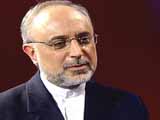|
|
TODAY.AZ / World news
Iran to build new enrichment site by March
17 August 2010 [09:50] - TODAY.AZ
Iran said it would build a new uranium enrichment site by early next year, state media reported Monday.
 The head of the Iranian Atomic Organization, Ali-Akbar Salehi, had said February that it would build 10 new enrichment sites within a year. Salehi said on state television Monday that the construction of at least one of the new plants would start by March 2011 but gave no details about its location. Iran currently has uranium conversion sites in Isfahan and Natanz, both in the central region.
The head of the Iranian Atomic Organization, Ali-Akbar Salehi, had said February that it would build 10 new enrichment sites within a year. Salehi said on state television Monday that the construction of at least one of the new plants would start by March 2011 but gave no details about its location. Iran currently has uranium conversion sites in Isfahan and Natanz, both in the central region.A third enrichment site is currently under construction in the Fordo village near the holy city of Qom, about 100 kilometres south of Tehran. The Fordo site is scheduled to become operational by the end of 2010 and at least 3,000 centrifuges are to be installed there. Iran says it ultimately aims to build 10 to 20 more sites to make enough nuclear fuel to cover its electricity needs.
The government has reportedly already chosen the locations for five more sites but no details are yet available. Russia announced Friday that it would provide the fuel for Iran's first nuclear power plant at Bushehr. Inspectors from the International Atomic Energy Agency (IAEA) were to attend the handover ceremony scheduled for August 21.
President Mahmoud Ahmadinejad ordered the government to enforce a law approved by the parliament last month to limit cooperation with the IAEA to the Non-Proliferation Treaty (NPT) framework. According to the framework, IAEA inspections of the nuclear sites would be more limited and not allow any unannounced visits.
The parliamentary bill and presidential order were mostly symbolic since Iran had suspended implementation of the IAEA Additional Protocol since 2005 and cooperates solely within the NPT framework. Ahmadinejad also ordered the government to pursue 20-per-cent uranium enrichment in the Natanz nuclear plant in central Iran and work on production of fuel rods for the Tehran medical reactor.
Iran began the enrichment process in February. Tehran claimed to have already produced 20 kilograms of 20-per-cent enriched uranium. The government also claimed it would be able to produce fuel rods for the Tehran reactor by March 2011, and then begin construction of a new reactor to replace it.
/Trend/
URL: http://www.today.az/news/regions/72221.html
 Print version
Print version
Views: 1683
Connect with us. Get latest news and updates.
See Also
- 27 September 2025 [23:30]
US 'betrayed' diplomacy, but E3 'buried' it - Iranian FM - 27 September 2025 [22:55]
Russian sub declares hazard after reported fuel failure - 27 September 2025 [22:10]
US to revoke visa for Colombian President over 'incendiary' comments - 27 September 2025 [21:38]
US House Democrats release Epstein files naming Musk, and Bill Gates - 27 September 2025 [09:00]
Paris court sentences Sarkozy to 5 years in prison for criminal conspiracy in Libya case - 27 September 2025 [08:00]
Digital ID to become mandatory for work in UK as government targets illegal migration - 26 September 2025 [09:00]
Hassett: China will lose AI race without Nvidia chips - 26 September 2025 [08:00]
Instagram remains threat to children - 25 September 2025 [09:00]
FIFA backs expanding World Cup to 64 teams - 25 September 2025 [08:00]
China: Trade with Russia in line with WTO rules
Most Popular
 Ter-Petrosyan epicly threw a piece of paper on the table: "It says it all!" - Gang of "exes" against Pashinyan
Ter-Petrosyan epicly threw a piece of paper on the table: "It says it all!" - Gang of "exes" against Pashinyan
 Baku hosts Azerbaijan & Central Asia Green Energy Week 2025
Baku hosts Azerbaijan & Central Asia Green Energy Week 2025
 Forbes: US should recognise Azerbaijan as a stabilising regional partner
Forbes: US should recognise Azerbaijan as a stabilising regional partner
 World Bank urges stronger regional cooperation on green energy exports
World Bank urges stronger regional cooperation on green energy exports
 Azerbaijan and Armenia’s FMs join transatlantic dinner hosted by US Secretary of State
Azerbaijan and Armenia’s FMs join transatlantic dinner hosted by US Secretary of State
 World Bank specialist calls for synchronising energy grid with power generation plans
World Bank specialist calls for synchronising energy grid with power generation plans
 Baku hosts conference on oil refining, petrochemicals, and trade in Caspian & Central Asia
Baku hosts conference on oil refining, petrochemicals, and trade in Caspian & Central Asia
